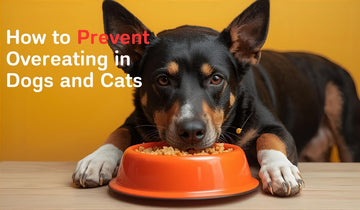Pets don’t just overeat because they’re “greedy.” Fast gulping, boredom, irregular schedules, and poor bowl design all nudge dogs and cats to consume more than they need. The good news: with the right hardware (slow feeders, elevated stands, portion control pet bowls) and a predictable routine, you can protect your pet’s digestion, weight, and mood—without turning mealtime into a battle.
Below is a professional, step-by-step guide you can implement today.
Why Dogs and Cats Overeat (Behavioral + Practical Triggers)
-
Pace & competition: Multi-pet homes create subtle pressure to eat quickly “before it’s gone.”
-
Bowl ergonomics: Deep, narrow bowls can trigger gulping and whisker stress in cats; light bowls slide and invite frantic eating.
-
Human error: Free-pouring kibble, using oversized scoops, and over-rewarding with treats adds hidden calories.
-
Boredom & anxiety: Pets self-soothe with food; fast eating becomes a habit loop.
-
Irregular timing: Skipped or delayed meals cause rebound overeating at the next feeding.
Health Risks of Overeating
-
GI upset: Regurgitation, gas, hiccups, and uncomfortable distension.
-
Weight gain & joint stress: Extra pounds burden hips, elbows, and the spine.
-
Metabolic issues: Elevated risk for diabetes (cats) and lipid disorders (dogs).
-
Behavioral fallout: Guarding around bowls, food obsession, and counter-surfing.
Portion Control 101 (Simple, Accurate, Sustainable)
-
Weigh the food. Measuring cups vary; a $10 kitchen scale eliminates guesswork.
-
Set a daily calorie target. Use your vet’s guidance; as a rough start, adjust portions to maintain an ideal body condition score (visible waist, ribs easily felt, not seen).
-
Apply the 10% rule. Treats ≤10% of daily calories; subtract treat calories from the main ration.
-
Split feedings. 2–4 smaller meals reduce bingeing and help satiety signals register.
-
Use the right bowl. Portion control pet bowls with volume marks or smaller footprints discourage over-serving.
Quick win: Pre-bag daily rations on Sunday. Each mealtime, empty one bag into the feeder—no more “just a little extra.”

Hardware That Helps (and Why It Works)
-
Dog slow feeders / cat slow feeders: Maze channels and lick surfaces force smaller bites and longer mealtime, cutting air intake and gulping.
-
Elevated stands (moderate height): Reduce neck strain and bowl chasing; especially useful for large dogs and seniors.
-
Heavy ceramic or non-slip stainless: Stability lowers arousal and noise; non-porous surfaces improve hygiene.
-
Puzzle feeders & snuffle formats: Convert food into “work,” burning mental energy and satisfying foraging needs.
Browse curated ceramic slow feeders, whisker-friendly plates, and elevated options at Noka & Aurorastone.
A 7-Step Plan to Stop Overeating (Dogs & Cats)
Step 1 — Set the Scene
Choose a quiet feeding station with a silicone mat. Consistency in place and time reduces anxious rush-eating.
Step 2 — Right Bowl, Right Pet
-
Dogs: match maze depth to muzzle length (brachycephalic → shallow channels).
-
Cats: wide, shallow, whisker-friendly dishes; add a cat slow feeder insert for kibble.
Step 3 — Split and Schedule
Feed 2–4 smaller meals at predictable times. For grazers, use micro-portions with puzzle plates.
Step 4 — Layer Textures
Wet smear (pumpkin or pate) on a lick surface beneath kibble; this slows early momentum and extends the meal to 10–20 minutes.
Step 5 — Pre-Meal Decompression
60–120 seconds of calm cues (sit/place) or sniffing play lowers arousal before the bowl appears—less frenzy, fewer giant mouthfuls.
Step 6 — Treat Accounting
Move high-value snacks into training sessions. If treats go up, kibble goes down by the same calories.
Step 7 — Track and Tweak
Watch stool quality, burps, and pace. If your pet finishes in under 3 minutes, add difficulty; if they give up, ease it slightly.
Cat-Specific Adjustments
-
Whisker fatigue fix: Wide, shallow ceramics prevent rim contact and floor-pawing behaviors.
-
Lick mats for wet food: Licking is rhythmic and calming; ideal for cats that “wolf and vomit.”
-
Water away from food: Many cats drink more when water is placed in a separate area, supporting satiety and urinary health.

Dog-Specific Adjustments
-
Scatter + bowl combo: Start 70% in the slow feeder, 30% scattered for foraging; gradually shift as pace improves.
-
Chew outlets: Provide safe chews post-meal to satisfy the oral drive without extra calories (choose low-calorie options and supervise).
-
Large breeds: Gentle elevation (1–3 in / 3–8 cm rim height) improves comfort and reduces bowl movement noise.
Regional Tips
-
Dog feeding tips USA: Dishwasher-safe ceramic or stainless for daily sanitation; consider winter-friendly, non-slip mats for tile/wood floors.
-
Portion bowl UK: Look for metric-marked bowls (g/ml). Micro-meals + puzzle plates are popular in multi-cat flats.
-
Slow feeder Canada: Heavier ceramic helps on slick flooring; freezer-friendly lick mats are great for summer enrichment.
-
Pet diet Australia: Heat-resistant glazed ceramics and elevated sets suit tiled, open-plan homes; focus on hydration in warmer months.

Troubleshooting
-
Still inhaling food? Smaller kibble size, deeper maze, or split the ration into two back-to-back puzzle formats (maze + lick).
-
Food guarding or tension? Feed pets separately; remove audience effect; keep sessions calm and timed.
-
Soft stools after changes? Transition feeders and foods over 5–7 days; introduce one change at a time.
-
Chronic vomiting, weight loss, or lethargy? Slow feeding addresses behavior, not disease—consult your vet.
Quick Checklist
-
□ Weigh each meal (no guessing)
-
□ Treats ≤10% and counted
-
□ Slow feeder matched to muzzle/whiskers
-
□ Consistent schedule and station
-
□ Record body condition monthly; adjust portions ±10% as needed
Make Mealtime Calm, Measured, and Healthy
Overeating is a solvable design problem. With portion control, routine, and the right feeder, your pet will eat slower, feel fuller, and digest better—day after day.
👉 Build your mealtime kit now: Noka & Aurorastone — elevated ceramics, whisker-friendly plates, and portion control pet bowls chosen to help stop dog overeating and support balanced pet diet routines across the USA, UK, Canada, and Australia.





